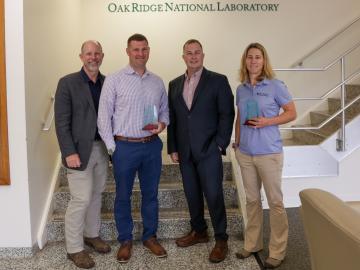
Filter News
Area of Research
- (-) Energy Science (54)
- (-) Materials (34)
- (-) National Security (48)
- Advanced Manufacturing (2)
- Biological Systems (1)
- Biology and Environment (91)
- Biology and Soft Matter (1)
- Computational Biology (1)
- Computational Engineering (1)
- Computer Science (4)
- Fuel Cycle Science and Technology (1)
- Fusion and Fission (4)
- Isotope Development and Production (1)
- Isotopes (10)
- Materials for Computing (8)
- Neutron Science (33)
- Nuclear Science and Technology (6)
- Quantum information Science (2)
- Supercomputing (121)
News Type
News Topics
- (-) Big Data (6)
- (-) Biomedical (9)
- (-) Clean Water (6)
- (-) Computer Science (39)
- (-) Environment (44)
- (-) Frontier (2)
- (-) Machine Learning (17)
- (-) National Security (36)
- (-) Space Exploration (2)
- (-) Summit (7)
- 3-D Printing/Advanced Manufacturing (61)
- Advanced Reactors (7)
- Artificial Intelligence (22)
- Bioenergy (30)
- Biology (13)
- Biotechnology (4)
- Buildings (19)
- Chemical Sciences (28)
- Composites (9)
- Coronavirus (11)
- Critical Materials (10)
- Cybersecurity (24)
- Energy Storage (58)
- Exascale Computing (3)
- Fossil Energy (2)
- Fusion (5)
- Grid (26)
- High-Performance Computing (11)
- Hydropower (1)
- Isotopes (11)
- ITER (1)
- Materials (69)
- Materials Science (59)
- Mathematics (2)
- Mercury (2)
- Microelectronics (1)
- Microscopy (20)
- Molten Salt (2)
- Nanotechnology (31)
- Neutron Science (36)
- Nuclear Energy (19)
- Partnerships (20)
- Physics (24)
- Polymers (13)
- Quantum Computing (2)
- Quantum Science (12)
- Security (14)
- Simulation (2)
- Transportation (38)
Media Contacts

When the COVID-19 pandemic stunned the world in 2020, researchers at ORNL wondered how they could extend their support and help

Researchers at ORNL are tackling a global water challenge with a unique material designed to target not one, but two toxic, heavy metal pollutants for simultaneous removal.

Though Nell Barber wasn’t sure what her future held after graduating with a bachelor’s degree in psychology, she now uses her interest in human behavior to design systems that leverage machine learning algorithms to identify faces in a crowd.

In front of family and friends, Lt. Col. Jessica Critcher and Maj. Micah McCracken gave their final report on their eye-opening year as ORNL military fellows.

Scientists develop environmental justice lens to identify neighborhoods vulnerable to climate change
A new capability to identify urban neighborhoods, down to the block and building level, that are most vulnerable to climate change could help ensure that mitigation and resilience programs reach the people who need them the most.

ORNL scientists will present new technologies available for licensing during the annual Technology Innovation Showcase. The event is 9 a.m. to 3 p.m. Thursday, June 16, at the Manufacturing Demonstration Facility at ORNL’s Hardin Valley campus.

It’s a simple premise: To truly improve the health, safety, and security of human beings, you must first understand where those individuals are.

What’s getting Jim Szybist fired up these days? It’s the opportunity to apply his years of alternative fuel combustion and thermodynamics research to the challenge of cleaning up the hard-to-decarbonize, heavy-duty mobility sector — from airplanes to locomotives to ships and massive farm combines.

Researchers at ORNL are teaching microscopes to drive discoveries with an intuitive algorithm, developed at the lab’s Center for Nanophase Materials Sciences, that could guide breakthroughs in new materials for energy technologies, sensing and computing.

ORNL researchers used the nation’s fastest supercomputer to map the molecular vibrations of an important but little-studied uranium compound produced during the nuclear fuel cycle for results that could lead to a cleaner, safer world.


